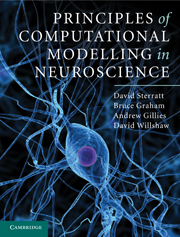Book contents
- Frontmatter
- Contents
- List of abbreviations
- Preface
- Acknowledgements
- Chapter 1 Introduction
- Chapter 2 The basis of electrical activity in the neuron
- Chapter 3 The Hodgkin–Huxley model of the action potential
- Chapter 4 Compartmental models
- Chapter 5 Models of active ion channels
- Chapter 6 Intracellular mechanisms
- Chapter 7 The synapse
- Chapter 8 Simplified models of neurons
- Chapter 9 Networks of neurons
- Chapter 10 The development of the nervous system
- Chapter 11 Farewell
- Appendix A Resources
- Appendix B Mathematical methods
- References
- Index
Chapter 10 - The development of the nervous system
Published online by Cambridge University Press: 05 June 2012
- Frontmatter
- Contents
- List of abbreviations
- Preface
- Acknowledgements
- Chapter 1 Introduction
- Chapter 2 The basis of electrical activity in the neuron
- Chapter 3 The Hodgkin–Huxley model of the action potential
- Chapter 4 Compartmental models
- Chapter 5 Models of active ion channels
- Chapter 6 Intracellular mechanisms
- Chapter 7 The synapse
- Chapter 8 Simplified models of neurons
- Chapter 9 Networks of neurons
- Chapter 10 The development of the nervous system
- Chapter 11 Farewell
- Appendix A Resources
- Appendix B Mathematical methods
- References
- Index
Summary
So far we have been discussing how to model accurately the electrical and chemical properties of nerve cells and how these cells interact within the networks of cells forming the nervous system. The existence of the correct structure is essential for the proper functioning of the nervous system, and in this chapter we discuss modelling work that addresses the development of the structure of the nervous system. Existing models of developmental processes are usually designed to test a particular theory for neural development and so are not of such wide application as, for example, the HH model of nerve impulse propagation. We discuss several examples of specific models of neural development, at the levels of individual nerve cells and ensembles of nerve cells.
The scope of developmental computational neuroscience
Modelling of the development of the nervous system has been intense, but largely restricted to the development of the features of neurons and networks of neurons in specific cases. This means that computational theories of, for example, neural precursors, or stem cells, are not considered, although they could be. A long-established field of research, the elegant mathematical treatment of morphogenetic fields, providing possible mechanisms by which continuous gradients of molecules called morphogens can be read out to specify regions of the brain in early development (Turing, 1952; Meinhardt, 1983; Murray, 1993), is conventionally regarded as the province of theoretical biology rather than of developmental computational neuroscience.
- Type
- Chapter
- Information
- Principles of Computational Modelling in Neuroscience , pp. 267 - 313Publisher: Cambridge University PressPrint publication year: 2011

